Mechanical Characteristics of Pre-Peak Unloading Damage and Mechanisms of Reloading Failure in Red Sandstone
Abstract
1. Introduction
2. Experimental Procedure and Protocol Design
2.1. Determination of Triaxial Compressive Strength under Specific Circumferential Pressure
2.2. Preparation of Pre-Peak Unloading-Damaged Sandstone
2.3. Uniaxial Re-Load Test of Damaged Rock Samples
2.4. Uniaxial Loading Test on Intact Sandstone
3. Identification of Feature Intensity
4. Re-Bearing Capacity Characteristics of Damaged Sandstone
4.1. Damaged Sandstone Stress–Strain Characteristics
4.2. Damaged Sandstone Characteristic Stress and Poisson’s Ratio Analysis
4.3. Damaged Sandstone Volumetric Strain Characteristics Analysis
4.4. Damaged Sandstone Crack Volume Strain Characteristics Analysis
5. Acoustic Emission Characteristics
6. Damage Pattern and Re-Load Damage Mechanism
6.1. Pre-Peak Unloading Rupture Pattern
6.2. Re-Load Damage Characteristics of Peak Front Unloading Sandstone
6.3. Reload Damage Mechanism of Sandstone before Peak Unloading
7. Conclusions
Author Contributions
Funding
Informed Consent Statement
Data Availability Statement
Conflicts of Interest
References
- Qiu, S.L.; Feng, X.T.; Xiao, J.Q.; Zhang, C.Q. An Experimental Study on the Pre-Peak Unloading Damage Evolution of Marble. Rock Mech. Rock Eng. 2014, 47, 401–419. [Google Scholar] [CrossRef]
- Li, J.L.; Zhu, Z.H.; Yu, L.Y.; Bai, J.W.; Sui, B.; Meng, Q.B.; Zhang, Z.Q. Dissipative Characteristics Investigation of Marble During Reloading Process Considering Pre-Peak Unloading Damage. Chin. J. Rock Mech. Eng. 2020, 39, 2429–2438. [Google Scholar]
- Zhou, Z.L.; Pi, Z.Z.; Jing, Y.; Wang, S.F. Responses of Pre-Holed Granite under Coupled Biaxial Loading and Unloading Stress Condition. Minerals 2022, 12, 372. [Google Scholar] [CrossRef]
- Zivaljevic, S.; Tomanovic, Z. Loading History Effect on Time-dependent Deformations after Unloading—reversible Creep of Soft Rock (marl). Mech. Time-Depend Mater. 2022, 26, 499–530. [Google Scholar] [CrossRef]
- Dai, B.; Zhao, G.Y.; Konietzky, H.; Wasantha, P.L.P. Experimental and Numerical Study on the Damage Evolution Behaviour of Granitic Rock during Loading and Unloading. KSCE J. Civ. Eng. 2018, 22, 3278–3291. [Google Scholar] [CrossRef]
- Huang, X.; Liu, Q.S.; Liu, B.; Pan, Y.C.; Liu, J.P. Experimental Study on the Dilatancy and Fracturing Behavior of Soft Rock Under Unloading Conditions. Int. J. Civ. Eng. 2017, 15, 921–948. [Google Scholar] [CrossRef]
- Li, J.Z.; Guo, P.H.; Yuan, A.Y.; Zhu, C.Q.; Zhang, T.; Chen, D.H. Failure Characteristics Induced by Unloading Disturbance and Corresponding Mechanical Mechanism of the Coal-seam Floor in Deep Mining. Arab. J. Geosci. 2021, 14, 1170. [Google Scholar] [CrossRef]
- Zhao, G.M.; Liu, C.Y.; Xu, W.S.; Meng, X.R. Experimental Study on the Failure Characteristics of High Stress Unloading Rock Mass Induced by Disturbance. J. China Coal Soc. 2021, 46, 412–423. [Google Scholar]
- Zhou, X.P.; Qian, Q.H.; Zhang, Y.X. The Constitutive Relation of Crack-Weakened Rock Masses under Axial-Dimensional Unloading. Acta Mech. Solida Sin. 2008, 21, 221–231. [Google Scholar] [CrossRef]
- Li, X.B.; Du, K.; Li, D.Y. True Triaxial Strength and Failure Modes of Cubic Rock Specimens with Unloading the Minor Principal Stress. Rock Mech. Rock Eng. 2015, 48, 2185–2196. [Google Scholar] [CrossRef]
- Meng, Q.B.; Liu, J.F.; Ren, L.; Pu, H.; Chen, Y.L. Experimental Study on Rock Strength and Deformation Characteristics Under Triaxial Cyclic Loading and Unloading Conditions. Rock Mech. Rock Eng. 2021, 54, 777–797. [Google Scholar] [CrossRef]
- Gong, F.Q.; Zhong, W.H.; Gao, M.Z.; Si, X.F.; Wu, W.X. Dynamic Characteristics of High Stressed Red Sandstone Subjected to Unloading and Impact Loads. J. Cent. South Univ. 2022, 29, 596–610. [Google Scholar] [CrossRef]
- Xu, X.T.; Huang, R.Q.; Li, H.; Huang, Q.X. Determination of Poisson’s Ratio of Rock Material by Changing Axial Stress and Unloading Lateral Stress Test. Rock Mech. Rock Eng. 2015, 48, 853–857. [Google Scholar] [CrossRef]
- Jiang, Q.; Feng, X.T.; Li, S.J.; Su, G.S.; Xiao, Y.X. Cracking-restraint Design Method for Large underground Caverns with Hard Rock under High Geostress Condition and Its Practical Application. Chin. J. Rock Mech. Eng. 2019, 38, 1081–1101. [Google Scholar]
- Wang, C.S.; Zhou, H.W.; Wang, R.; Wang, Z.H.; He, S.S.; Liu, J.F. Failure Characteristics of Beishan Granite under Unloading Confining Pressures. Chin. J. Geotech. Eng. 2019, 41, 329–337. [Google Scholar]
- Fu, J.X.; Song, W.D.; Tan, Y.Y. Experimental Study of the Characteristics of Strength and AE of Diorite Porphyrite under Complex Loading and Unloading Path. Chin. J. Rock Mech. Eng. 2016, 35, 3858–3867. [Google Scholar]
- Hou, Z.Y.; Xiao, F.K.; Liu, G.; Bashkov, O.V.; Lyu, L. Mechanical Properties and Acoustic Emission Characteristics of Unloading Instability of Sandstone under High Stress. Minerals 2022, 12, 722. [Google Scholar] [CrossRef]
- Fan, Z.Q.; Jin, Z.H.; Johnson, S.E. Modelling petroleum migration through microcrack propagation in transversely isotropic source rocks. Geophys. J. Int. 2012, 190, 179–187. [Google Scholar] [CrossRef]
- Hou, G.Y.; Liang, J.P.; Zhou, M.H.; Cui, Y.K. Effect of Unloaing Velocity on Surrounding Rock Deformation. J. China Coal Soc. 2019, 44, 1011–1019. [Google Scholar]
- Martin, C.D.; Chandler, N.A. The progressive fracture of Lacdu Bonnet granite. Int. J. Rock Mech. Min. Sci. Geomech. Abstr. 1995, 32, 41. [Google Scholar]
- Zhao, Y.G.; Huang, L.Q.; Li, X.B. Identification of Stages before and after Damage Strength and Peak Strength Using Acoustic Emission Tests. Chin. J. Geotech. Eng. 2022, 44, 1908–1916. [Google Scholar]
- Sha, Z.H.; Hai, P.; Xu, J.C.; Ni, H.Y.; Guo, S.R. Effects of Accumulated Damage on the Dynamic Properties of Coal Measures Sandstone. Minerals 2022, 12, 810. [Google Scholar] [CrossRef]
- Jin, Z.H.; Johnson, S.E.; Fan, Z.Q. Subcritical propagation and coalescence of oil-filled cracks: Getting the oil out of low-permeability source rocks. Geophys. Res. Lett. 2010, 37, 1. [Google Scholar] [CrossRef]
- Wang, B.L.; Mai, Y.W. Fracture of a Piezoelectric Material Layer Bonded by Two Elastic Layers. Int. J. Eng. Sci. 2002, 40, 1697–1727. [Google Scholar] [CrossRef]
- Zheng, A.X.; Luo, X.Q. Research on Combined Fracture Criterion of Rock under Compression-shear Stress. Rock Soil Mech. 2015, 36, 1892–1898. [Google Scholar]
- Wang, J.J.; Huang, S.Y.; Guo, W.L.; Zhao, T.L. Compression-shear Tension Fracture Criteria for Rock-like Materials Considering Geometric Characteristics of Cracks and T-str. Chin. J. Geotech. Eng 2020, 42, 1622–1631. [Google Scholar]



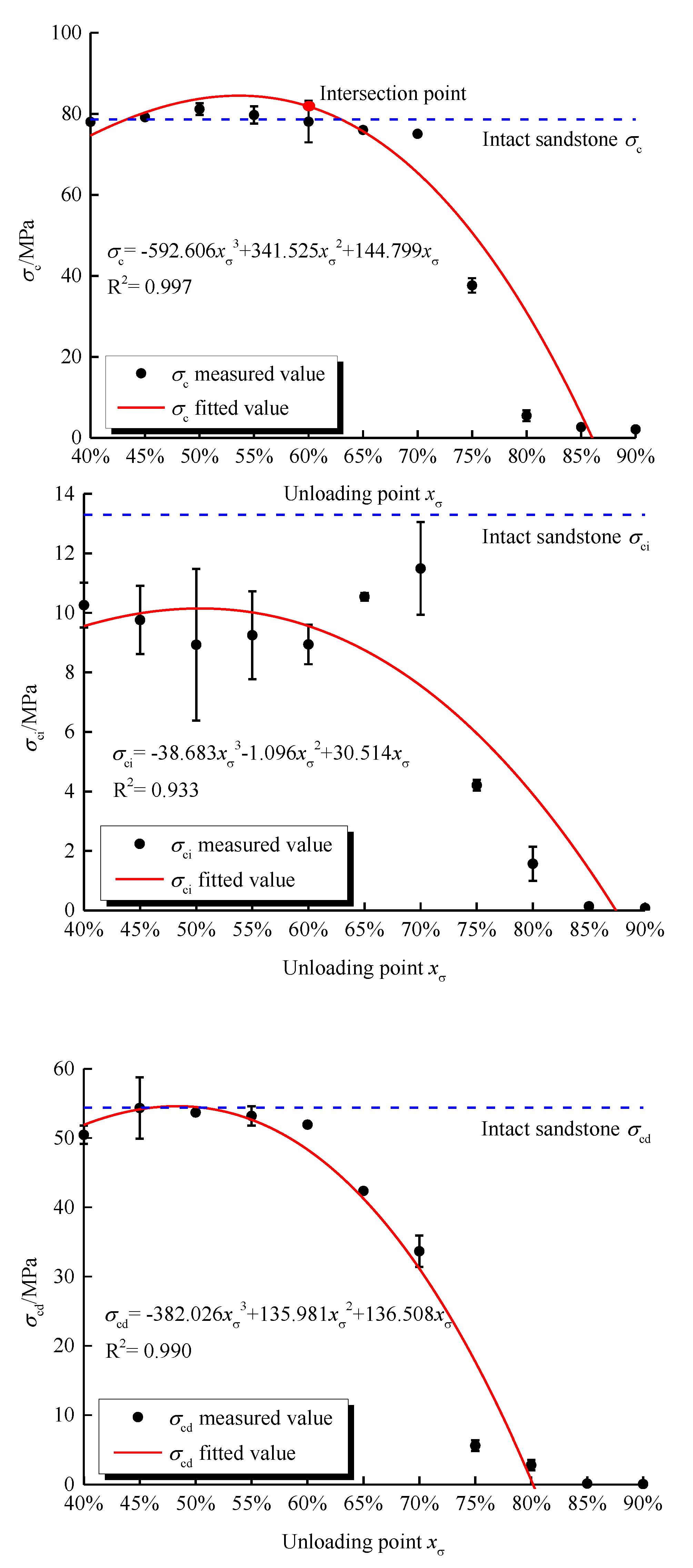
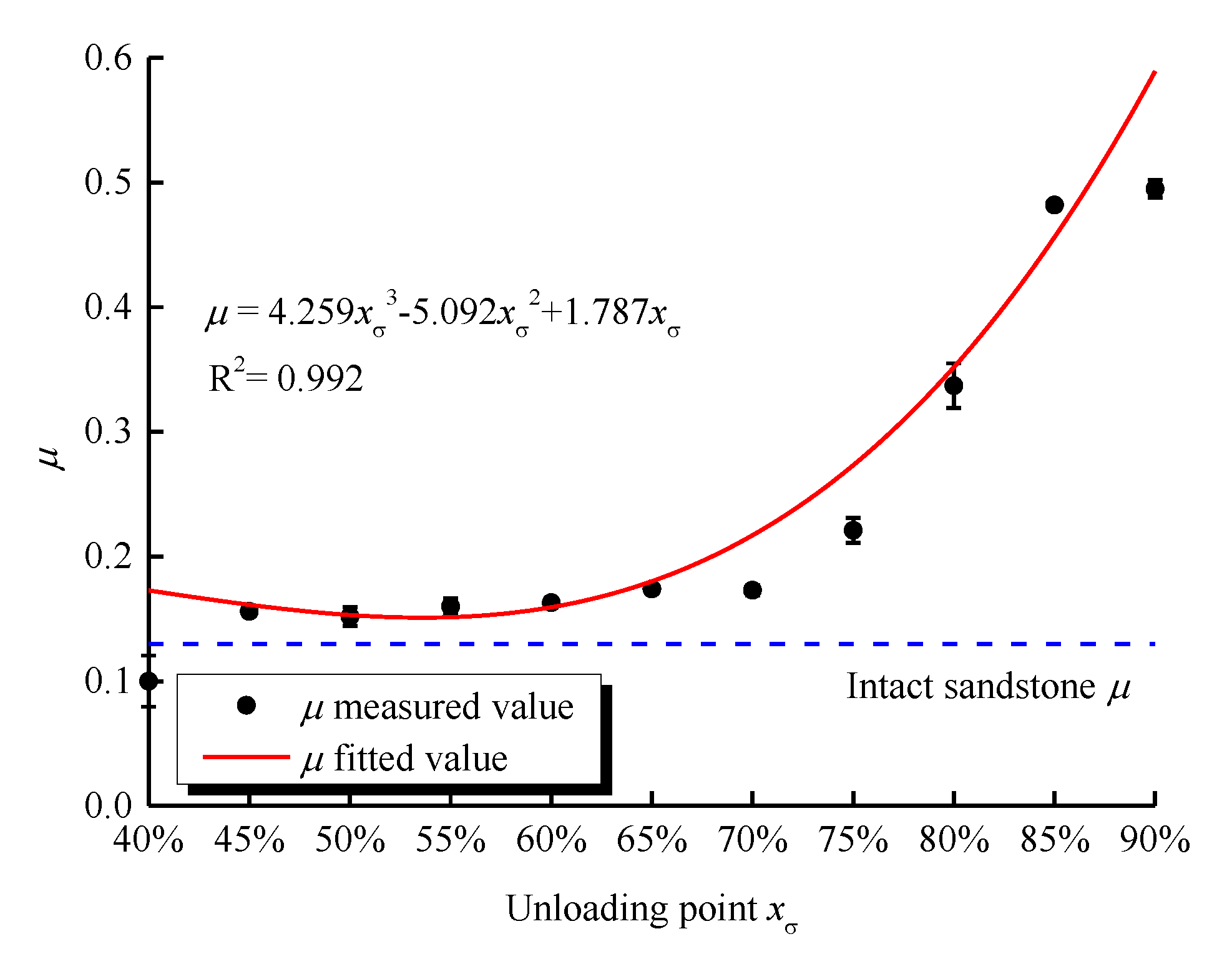



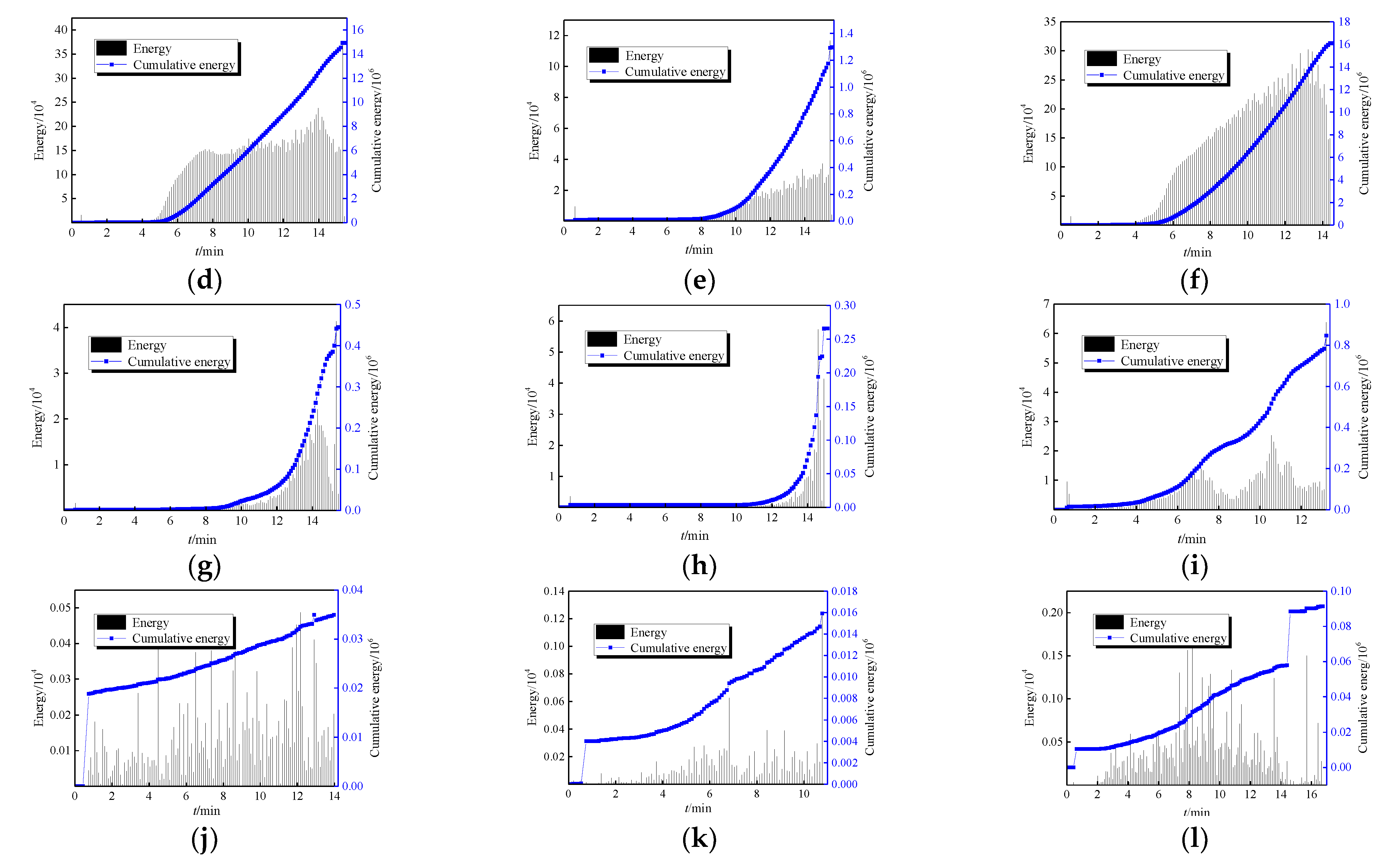
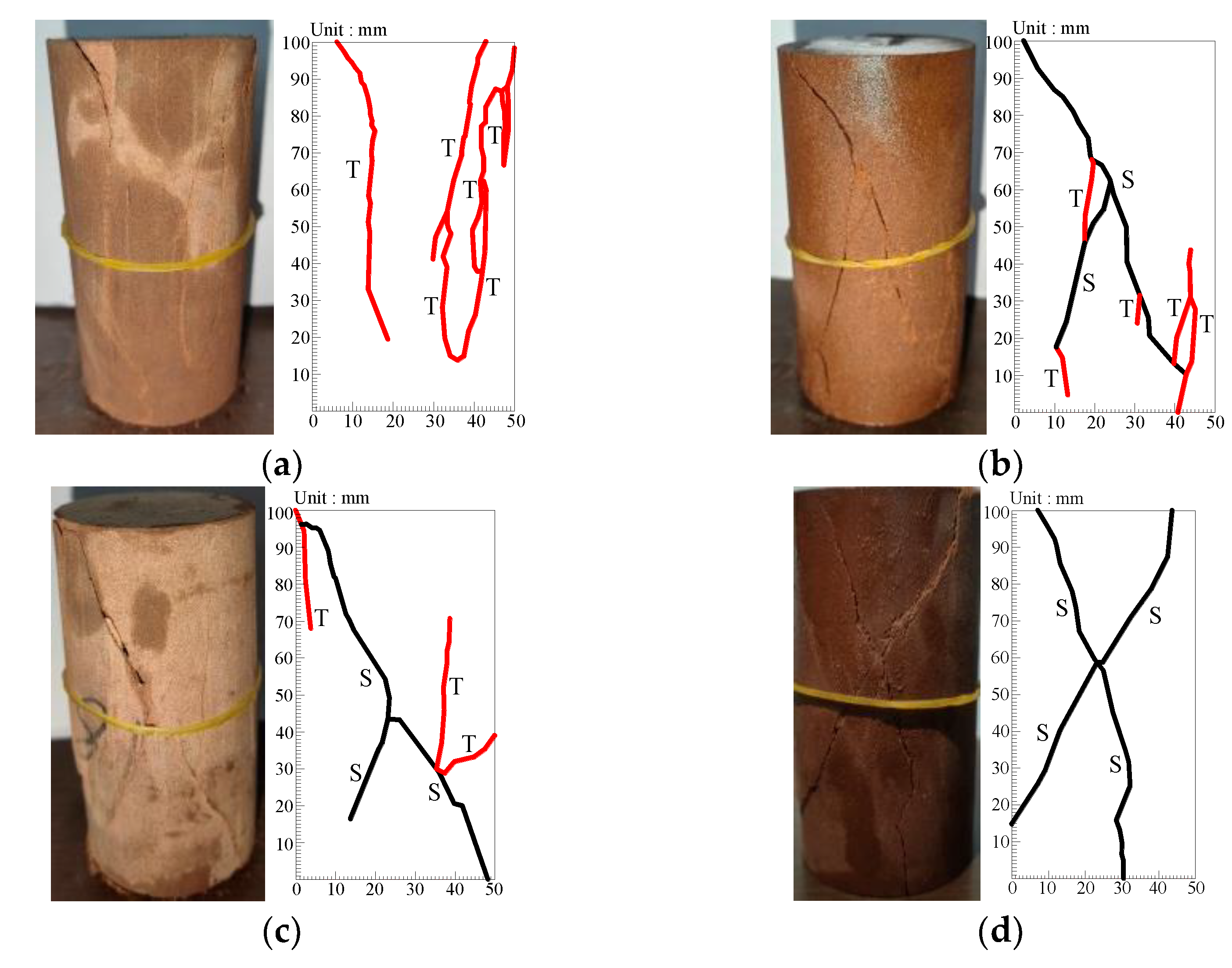
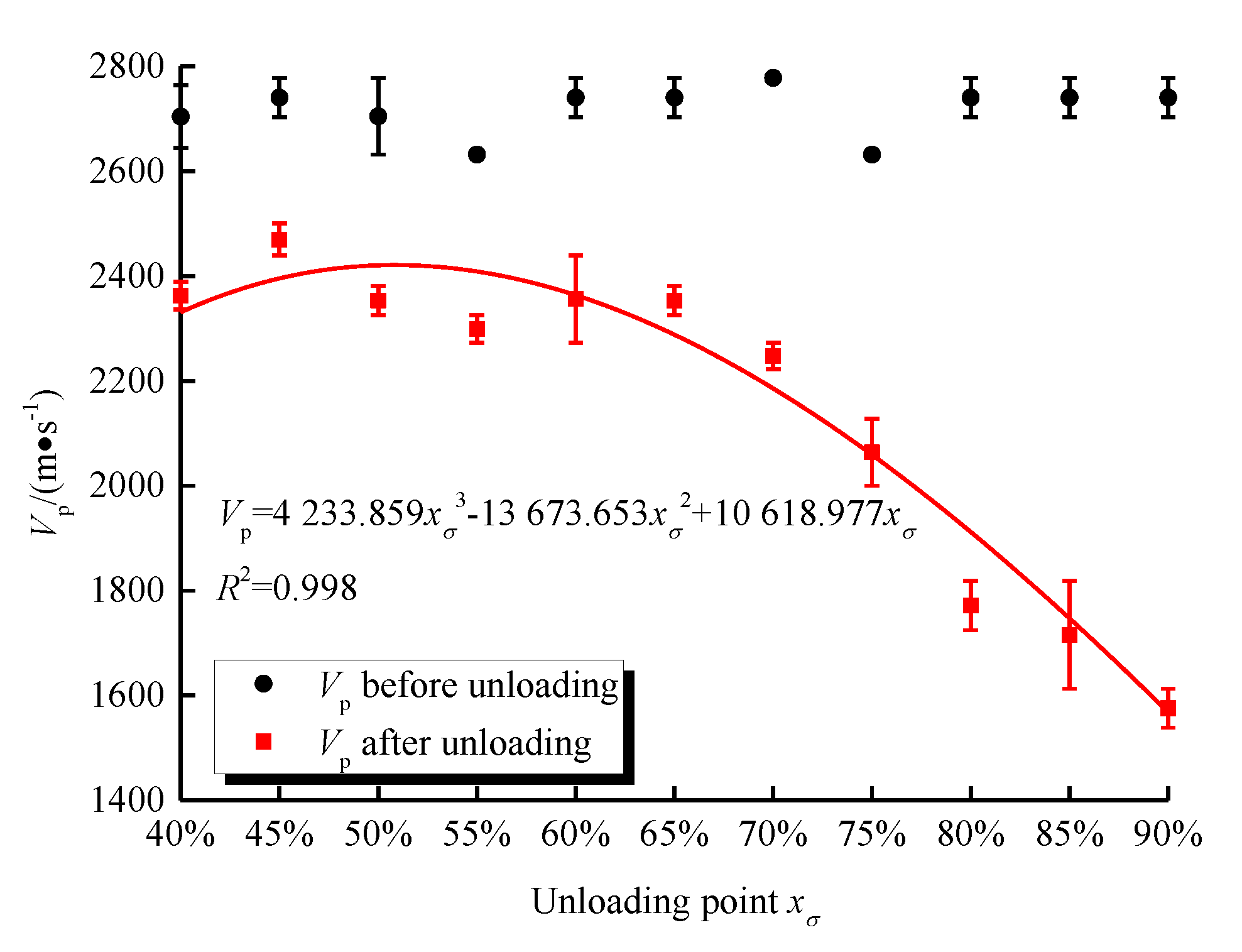
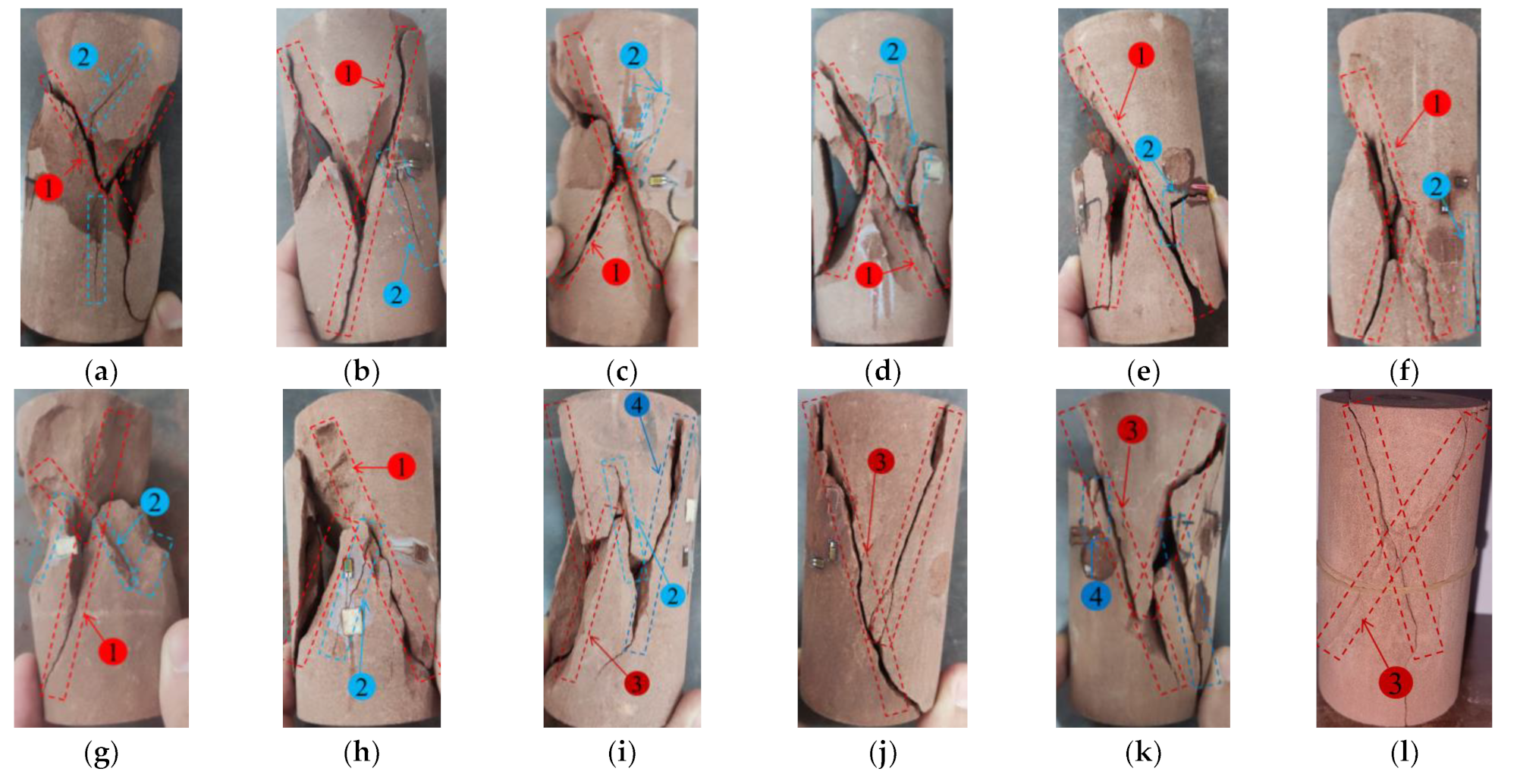



| Test Type | Unloading Point | σci /MPa | σcd /Mpa | σc /Mpa |
|---|---|---|---|---|
| Single-axis | / | 13.30 | 54.40 | 78.63 |
| Single-axis after injury | 40% | 10.26 | 50.47 | 78.93 |
| 45% | 9.76 | 54.35 | 79.15 | |
| 50% | 8.93 | 53.70 | 81.16 | |
| 55% | 9.25 | 53.20 | 79.70 | |
| 60% | 8.94 | 51.95 | 78.06 | |
| 65% | 10.54 | 42.36 | 76.01 | |
| 70% | 11.49 | 33.65 | 75.05 | |
| 75% | 4.21 | 5.63 | 37.65 | |
| 80% | 1.57 | 2.82 | 5.50 | |
| 85% | 0.14 | 0.14 | 2.68 | |
| 90% | 0.08 | 0.08 | 2.14 |
Publisher’s Note: MDPI stays neutral with regard to jurisdictional claims in published maps and institutional affiliations. |
© 2022 by the authors. Licensee MDPI, Basel, Switzerland. This article is an open access article distributed under the terms and conditions of the Creative Commons Attribution (CC BY) license (https://creativecommons.org/licenses/by/4.0/).
Share and Cite
Zhu, Y.; Li, P.; Wang, P.; Mei, C.; Ren, H.; Wang, X. Mechanical Characteristics of Pre-Peak Unloading Damage and Mechanisms of Reloading Failure in Red Sandstone. Appl. Sci. 2022, 12, 13046. https://doi.org/10.3390/app122413046
Zhu Y, Li P, Wang P, Mei C, Ren H, Wang X. Mechanical Characteristics of Pre-Peak Unloading Damage and Mechanisms of Reloading Failure in Red Sandstone. Applied Sciences. 2022; 12(24):13046. https://doi.org/10.3390/app122413046
Chicago/Turabian StyleZhu, Yongjian, Peng Li, Ping Wang, Chengcheng Mei, Heng Ren, and Xizhi Wang. 2022. "Mechanical Characteristics of Pre-Peak Unloading Damage and Mechanisms of Reloading Failure in Red Sandstone" Applied Sciences 12, no. 24: 13046. https://doi.org/10.3390/app122413046
APA StyleZhu, Y., Li, P., Wang, P., Mei, C., Ren, H., & Wang, X. (2022). Mechanical Characteristics of Pre-Peak Unloading Damage and Mechanisms of Reloading Failure in Red Sandstone. Applied Sciences, 12(24), 13046. https://doi.org/10.3390/app122413046





